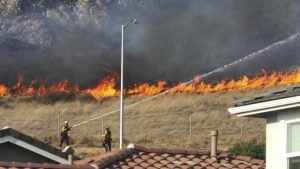![]()
California once again evaded rolling blackouts Sunday after residents dramatically curbed electricity use during a record-breaking heat wave — but the state’s energy crisis is far from over.
The sweltering temperatures are fueling wildfires that have, just this weekend, taken down power plants, forced evacuations and cut power to about 70,000 homes and businesses. Even when the heat begins to dissipate on Monday, offshore winds forecast to hit Northern California will stoke the risk of more fires, likely forcing even more outages.
Such is life in a changing climate: More extreme weather inciting more frequent blazes, and an electric grid struggling to cope with unprecedented heat. San Francisco on Sunday hit 100 degrees Fahrenheit (38 degrees Celsius), smashing a prior record of 92 set in 1904, according to the National Weather Service. Los Angeles reached 111 and San Diego topped 100, also records.
The California Independent System Operator, which runs most of the state’s grid, credited consumers with averting what would have been the largest blackout in state history and the third round of rolling outages in less than a month. But for some Californians, dialing back their air conditioners won’t be enough to keep the lights on as wildfires rage across the state.
Utility giant PG&E Corp. warned that more than 100,000 customers may go dark late Monday in parts of the San Francisco Bay area and Sierra Nevada foothills in a bid to keep its power lines from igniting fires. It’s the first time this fire season that PG&E has warned of shutoffs.
Last year, when California’s utilities first began carrying out widespread blackouts like this, some homes and businesses were left in the dark for days. That drew outrage from state and local officials, triggered investigations and prompted PG&E to reassess the scope of future shutoffs.
Years of deadly fires started by PG&E’s wires in wind storms forced California’s largest utility to declare bankruptcy last year. The company emerged in July after agreeing to pay $25.5 billion to settle wildfire lawsuits. The state has since set up a wildfire liabilities fund, essentially an insurance pool for the region’s utilities, but just one catastrophic blaze could wipe it out.
Wreaking Havoc
The latest blazes are already wreaking havoc on the grid. The Creek Fire in the Sierra Nevada Mountains, which has scorched 45,500 acres and is not contained, knocked out transmission from a hydro plant on Saturday. Another fire in Southern California cut off a solar farm, the California ISO said. Together, the blazes sucked 1.6 gigawatts from the power system, enough to power 1.2 million homes. While half of that had been re-connected by midday Sunday, another fire took out 500-600 megawatts.
By Sunday evening, the heat had also taken down a 900-megawatt transmission line from Oregon, prompting the grid operator to call a Stage 2 emergency — the last step before rolling blackouts. Southern California electricity prices briefly jumped to $1,164 a megawatt-hour while prices in Northern California surged to the highest level since January.
Over the next two hours, officials called on consumers to turn off lights and appliances, to keep the grid from collapsing. It worked, but the ISO warned that it isn’t over yet.
“Temperatures tomorrow will continue to be hot throughout the western U.S.,” the grid operator said in a statement. “The ISO is also monitoring numerous wildfires that may impact electrical lines.”
Unprecedented Heat
The Department of Energy earlier Sunday issued an emergency order allowing several more power plants to produce as much electricity as possible over the next seven days, even if doing so would otherwise violate anti-pollution rules. At the ISO’s request, the agency said it was authorizing power plants in the City of Industry, El Segundo and Long Beach to run at their maximum output levels — even though it may unleash additional air pollution. In a statement, agency spokesperson Shaylyn Hynes said California policymakers should “evaluate why the grid is not able to handle extreme stress, which could be alleviated with the support of greater baseload power generation and natural gas supply.”
One thing that has made California’s grid so vulnerable to soaring demand is the state’s rapid shift away from natural gas. About 9 gigawatts of gas generation, enough to power 6.8 million homes, have been retired over the past five years as the state turns increasingly to renewables, according to BloombergNEF. That leaves fewer options when the sun sets and solar production wanes. The state’s utilities have commissioned large battery packs to pick up the slack, but most of the batteries haven’t been installed yet.






